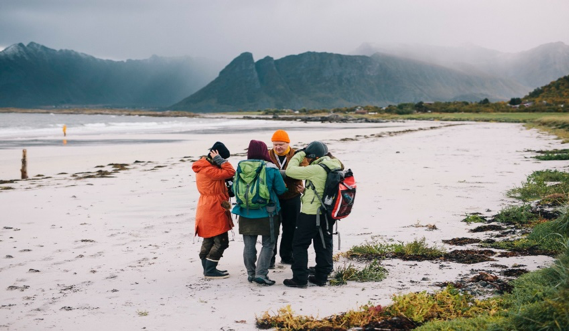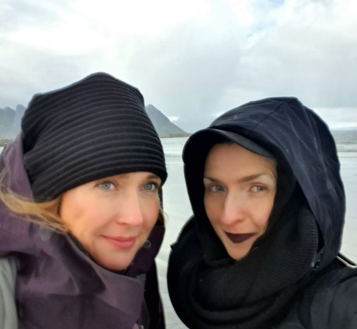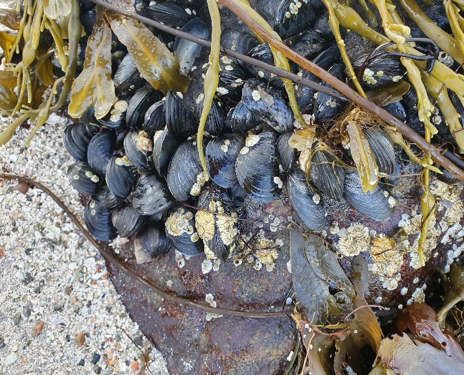The Kelp Congress at the Lofoten International Arts Festival (LIAF) included one week of intense research workshops and an interdisciplinary congress in northern Norway. It was centered around the topic of kelp, while considering resilience, resources, community and communication from human and other-than-human perspectives.
The Kelp Congress was initiated by LIAF 2019, together with Annette Wolfsberger, and with input from the Posthumanities Hub and several other research centres and artist-run organisations based in the Nordic countries and Northwest Russia: ArtLab Gnesta, Fridaymilk, Laboratory for Aesthetics and Ecology, Mustarinda, Skaftfell – Center for Visual Art, and The Department of Seaweed.
The Kelp Congress saw, among other things, a key note talk by Cecilia Åsberg, Planetary Speculation: Cultivating Curiosity Concern and Care, Collaboratively, and participation in the workshops/research strands Curing with Kelp and Coast, Line by Janna Holmstedt, Cecilia Åsberg, and Marietta Radomska. The film above capture some of the events and excursions.


Grape wrack with tasty fruits, and Kelp Congress keynote speaker Cecilia Åsberg.
The research strands Curing with Kelp and Coast, Line
In the weekdays ahead of the weekend congress itself, artists and other explorers of kelp-relationality convened at three different settings on the islands of Lofoten for intense workshopping. The grape-like fruits (genitalia) of the kelp (left) proved a delicious, salty umami flavored, addition to our dinner salads in the House of Artists where one of the three exploratory workshops took place, Kelp Curing, guided by Sarah Blissett. This workshop explored collective recipe-writing, cooking and making-with Kelp through encounters in and beyond the intertidal zone. Through indeterminacy, play and slow processing of a range of literatures red off beaches or books, we entered into modes of collaborative practice with one another as multispecies human beings, and with nonhuman beings like wracks, kelps, sea urchins, sandy intertidal zones, sea shells, and the brisk September weather.
A foraging excursions with artist and master chef Øyvind Novak Jenssen, as part of the Kelp Curing research strand where we cultivated, concocted and curated with macro-algae (Photo by Michael Miller). Photo of pre-snow Marietta Radomska and Cecilia Åsberg, musing on that same windy beach.
Our skills in the methodology of paying attention were honed in the intertidal zones, where patterns of flux and formation revealed themselves in the sand, in the ebbs and flows of water, in the flotsam and jetsam that the sea gifted or returned to us, and in the deep time geological formations of the mountains surrounding us. In this workshop, curing was approached as a material-discursive framework through practice-making with kelp in terms of sustenance, preservation, caring and curation. We made kelp kombucha tea, truffle kelp pasta salad, kelp conserves, sea side curiosity cabinets, and of course, saw lots of macroalgae creativity, kelp sound art, especially. After all, we all were there to listen in and pay attention, collaboratively and curiously together.
Sea urchins, an invasive species that can devour macroalgae like sugar kelp and bladderwrack like there is no tomorrow, also in turn get consumed by sea birds, otters and, yes resarchers. In fact, in retrospect it appears some of us ate a lot of sea side genitalia, from macroalgae and urchins, to no greater avail but for discovering the strange alienness of life forms that have been spreading on the planet longer than us humans. Of course a few forbidden conversations ensued in the following days of feminist fun, inspired by Haraway, Tsing, Barad and Ursula Le Guin’s carrier bag-theory of kelp story-telling.

Performance preparation as part of the Coast, Line research strand, Julia Lohman from the Department of Seaweed and Janna Holmstedt, the Posthumanities Hub. Photo byAlexander Kozachek.
We will eventually share with you a longer essay for a Kelp publication, coordinated by the LIAF Kelp curators!



